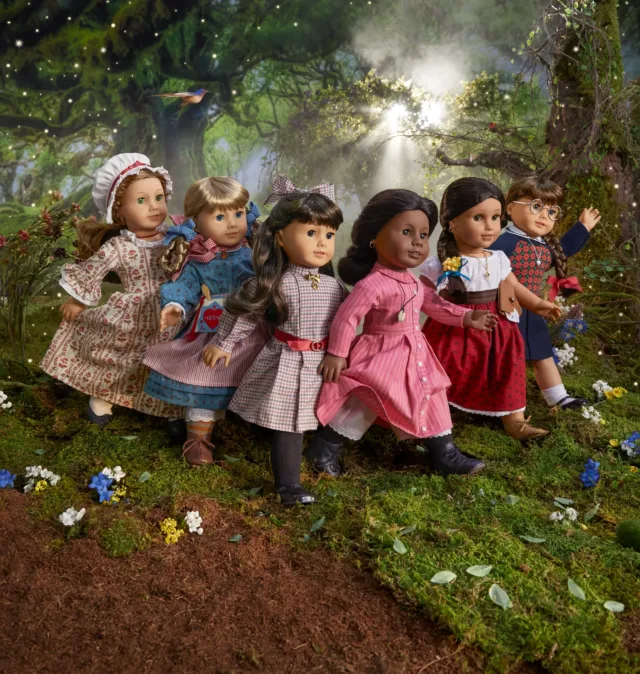
From The American Scholar:
“Since the beginning of time—since the first little girl ever existed—there have been dolls.” So proclaims Helen Mirren in the opening scene of Greta Gerwig’s summer blockbuster, Barbie. “But the dolls were always and forever baby dolls,” she says—that is, until Barbie came along. “Yes,” Mirren says, “Barbie changed everything.”
Twenty-seven years after Ruth Handler brought that iconic blonde into the world, another woman found herself fed up with baby dolls and Barbies. Pleasant Rowland, a newscaster turned educational product developer, thought girls deserved dolls that nurtured their interests beyond fashion and motherhood. In 1986, she created American Girl: a line of meticulously researched dolls, clothes, accessories, and books inspired by pivotal moments in American history. The brand was a hit. In its first four years, Rowland’s Pleasant Company turned a profit of $30 million.
American Girl is as much a phenomenon today as it was in the ’80s—and not just among children. Adult collectors, cosplayers, and meme creators abound. The dolls crop up in pop culture juggernauts from Saturday Night Live to The Last of Us. It’s no secret why: according to Mary Mahoney and Allison Horrocks, authors of Dolls of Our Lives, Rowland’s “genius lay in articulating a vision of girlhood she could shape through her company, a vision that would influence how girls saw themselves, the kind of play that helped them create themselves and memories along the way.”
Mahoney and Horrocks are historians whose childhood love for American Girl brought them together in graduate school. Dolls of Our Lives began in 2019 as a podcast originally titled American Girls, and the two were floored by the response it received. “Lots of listeners who didn’t grow up to pursue history as a career wanted to be part of this burgeoning community,” they write. “What bound us together was the fact that these stories still seemed to have a lot to teach us.”
As Mahoney and Horrocks tell it, American Girl’s runaway success was grounded not only in its innovative combination of dolls and tie-in educational products, but also in its commitment to take young girls seriously. Inspired by a childhood visit to Colonial Williamsburg, Rowland recognized the appeal and power of placing girls in an imagined version of the past. She and her team of designers created nine-year-old characters at once relatable and aspirational, beginning with Kirsten (a hard-working 19th-century Swedish immigrant adjusting to her new home in Minnesota), Samantha (a bookish Victorian orphan with a gift for public speaking), and Molly (a World War II–era Scottish American who tries constantly to reinvent herself). These initial dolls and their successors represent an ideal sort of girlhood, facing hardships large and small with just the right amount of loyalty and courage.
As American Girl’s revenues increased, so did its output. By the ’90s, it had become a “full-blown lifestyle brand.” Pleasant Company released cookbooks, craft books, and other supplements to its historical character lines, plus contemporary growing-up guides like the much-beloved The Care and Keeping of You, a sort of Puberty 101 for pre-adolescent girls. (It was recently revamped to be more inclusive.) American Girl magazine launched in 1992, a “space [for girls] to talk about the anxieties and triumphs of growing up in their own words … without making them the subject of a joke or shaming them.” In 1995, the company introduced a doll line called “Girl of Today,” allowing girls to select a doll that looked like them (or, in many cases, a friend or sister they longed to have). “She’s just like you, you’re a part of history, too!” declared one catalogue snippet.
For women of a certain age, the print catalogue has become the stuff of legend. “The only thing better than owning something from American Girl was dreaming about buying something from the American Girl catalogue,” write Mahoney and Horrocks. Doll owners and their hopeful counterparts drooled over the catalogue’s expensive offerings and tantalizing descriptions, some even pushing their parents to read from it “as if it were a Dickens novel.”
Link to the rest at The American Scholar
For any male visitors who might be tempted to make sexist comments about females and dolls, PG notes:

Glad to see Super Queens in the mix. However, where were the “action figures” for girls?
No idea.
(Perhaps some tomboys?)
The line didn’t last. Clearly ahead of the times.
In fact I’m pretty sure the American Girls would’ve failed, too.
It was the ’60’s.
Wait a bit and watch people roll their eyes and shrug: “What can you say? It was the ’20’s!”
See https://www.bing.com/shop?q=wonder%20woman%20doll%201970s&FORM=SSAT01&originIGUID=0CC4F35B8AD645088AE8AE3FA96F25AB.
Several varieties – including a Barbie version (LOL!)
The IDEAL ones from the 60’s run 4 figures and up:
https://www.ebay.com/sch/i.html?_nkw=super%20queens%20ideal&norover=1&mkevt=1&mkrid=711-34002-13078-0&mkcid=2&mkscid=102&keyword=super%20queens%20ideal&crlp=_&MT_ID=&geo_id=&rlsatarget=kwd-77172148849155:loc-190&adpos=&device=t&mktype=&loc=154&poi=134019&abcId=&cmpgn=395409297&sitelnk=&adgroupid=1234751765211209&network=o&matchtype=e&msclkid=137ae06803b91590bfda851a661dcfac
One of the Batgirls might be fake. Blonde? The box and others show her redheaded as proper.
The doll collectibles market requires deep(ish) pockets.
I’ll see your G.I. JOE and raise you one CAPTAIN ACTION. 😀
http://www.mwctoys.com/REVIEW_031212a.htm
He had a short (marketing driven) comic series in the 60’s that was surprisingly good and well ahead of its time. Ridiculously hard to find these days. (The one time I dabbled into a convention. Last, too.)
Wikipedia:
https://en.m.wikipedia.org/wiki/Captain_Action
“Captain Action was an action figure created in 1966, equipped with a wardrobe of costumes and facial masks allowing him to become Superman, Batman, Spider-Man, Captain America, Aquaman, the Phantom, The Lone Ranger (and Tonto), Flash Gordon, Buck Rogers, Sgt. Fury, Steve Canyon, and the Green Hornet. Captain Action was the Ideal Toy Company’s answer to Hasbro’s G.I. Joe, although the protagonist dolls of both toy lines were created and designed by the same toy-and-idea man, Stan Weston. Captain Action also had a working 4 foot (1.2192 meter) parachute.
Toy developer Stan Weston went to Hasbro’s Don Levine with the idea of an articulated doll in the form of a soldier — a basic figure, and with limitless accessories. Levine and his Hasbro team took the concept, making it into G.I. Joe, the first modern action figure for boys — and the first to carry the action figure generic name, an attempt to remove the term “doll” from a toy for boys. Weston took his money from the G.I. Joe venture and founded his own licensing company, representing DC Comics, Marvel Comics, and King Features Syndicate.
After the success of G.I. Joe, Stan Weston’s company, Leisure Concepts, then brought the idea of a new, articulated, twelve-inch (305 mm) action figure to Ideal Toys Corporation, who were seeking an action figure of their own, to remain competitive in the toy market. Weston proposed Captain Magic, a many-in-one hero, who could adopt the guise of several heroes, all of whom Leisure Concepts represented. The name was changed to Captain Action, and first marketed by Ideal in 1966.
The figure itself had a rather sad and worried expression, a strange shaped head (so the masks of the various heroes would better stay in place over it) and a more detailed musculature than G.I. Joe’s. The original Ideal base for the line was Captain Action in his blue and black uniform, with lightning sword and ray gun included in the box. Separate Superman, Batman, Lone Ranger, The Phantom, Flash Gordon, Captain America, Sgt Fury, Steve Canyon and Aquaman costumes (with accessories) were available;[1] the next wave (1967) added Spider-Man, Buck Rogers, the Green Hornet, and Tonto, with a Blue Lone Ranger variation (matching the still popular Clayton Moore series) and collectible flicker rings in each box.
In 1967, Captain Action proved popular enough to expand the line, adding a partner, Action Boy, and an enemy, Dr. Evil, a blue skinned alien with large bug eyes and an exposed brain, wearing a modified Nehru suit and sandals. A line of female figures was also released called the “Super Queens Posin’ Dolls”, which featured Batgirl, Mera, Supergirl, and Wonder Woman figures. Unlike Captain Action and Action Boy, the Super Queens dolls were each individually based on a singular superheroine (instead of a base “Super Queen” doll with interchangeable outfits).[2] Also, a vehicle called the “Silver Streak”, a 2-foot-long (0.61 m) amphibian car with missile launchers, was added, large enough for both the Captain and sidekick. Several sets meant to be used by Captain Action in his Captain Action identity were designed for the character as well: a four foot working parachute, a jet mortar, a jet pack, a weapons arsenal, and several other secret weapons to add to the Action Cave, which the special box for the Streak could convert into. Both the Captain and Dr. Evil received “secret lairs”, which doubled as carrying cases for the figures, but which are now quite rare. All of this was an attempt by Ideal to build the “Action” line and focus on Captain Action as a hero in his own right, rather than just a base figure for other heroes.
After just a couple of years, the Captain Action line declined in sales. As a result, Ideal Toys discontinued it in 1968. Though Captain Action was produced for only two and a half years, the characters and accessories have become amongst the most fondly remembered, and expensive to obtain on the collector’s market, action figures of the era.”